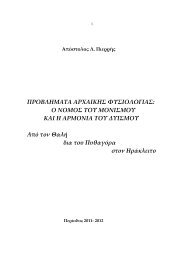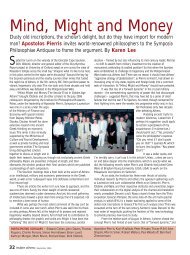chapter 10 the monism of darkness and the dualism of limit and ...
chapter 10 the monism of darkness and the dualism of limit and ...
chapter 10 the monism of darkness and the dualism of limit and ...
Create successful ePaper yourself
Turn your PDF publications into a flip-book with our unique Google optimized e-Paper software.
<strong>10</strong>6 CHAPTER <strong>10</strong><br />
28. The manuscripts have KÚfiÓÔÓ but Zoegas’ emendation is obvious. When<br />
Cronos is put in <strong>the</strong> supreme position (as in Pherecydes) <strong>the</strong>n his name<br />
hints at Time. When, by contrast, <strong>the</strong> Titan <strong>of</strong> Mythology is also present,<br />
<strong>the</strong>n Chronus at <strong>the</strong> beginning <strong>of</strong> <strong>the</strong> sequence is not Cronos. The Orphic<br />
teachings in all variations certainly comprised <strong>the</strong> myths about Cronos. Cf.<br />
Orphic Argonautica v. 426.<br />
29. Ovid presents this <strong>the</strong>ory <strong>of</strong> first principles <strong>and</strong> aboriginal beginnings also<br />
as a symbolic interpretation <strong>of</strong> <strong>the</strong> double-faced god Ianus. Fasti I <strong>10</strong>3 sqq.:<br />
<strong>the</strong> god is speaking:<br />
Me Chaos antiqui, nam sum res prisca, vocabant.<br />
Aspice, quam longi temporis acta canam.<br />
Lucidus hic aer, et quae tria corpora restant,<br />
ignis, aquae, tellus, unus acervus erant.<br />
Ut semel haec rerum secessit lite suarum<br />
inque novas abiit massa soluta domos,<br />
altum flamma petit; proprior locus aera cepit:<br />
sederunt medio terra fretumque solo.<br />
Tunc ego, qui fueram globus (= Empedocles’ Sphairos) et sine<br />
imagine moles,<br />
in faciem redii dignaque membra deo.<br />
...<br />
117 Quicquid ubique vides, caelum, mare, nubila, terras,<br />
omnia sunt nostra clausa patentque manu.<br />
Me penes est unum vasti custodia mundi,<br />
et ius vertendi cardinis omne meum est.<br />
Here <strong>the</strong> transition from <strong>the</strong> formlessness <strong>of</strong> primaeval Indeterminacy<br />
(\AappleÂÈÚ›·) to <strong>the</strong> present World-Order is an internal development that<br />
accords with <strong>the</strong> Monism <strong>of</strong> Darkness. In <strong>the</strong> Metamorphoses, on <strong>the</strong> o<strong>the</strong>r<br />
h<strong>and</strong>, <strong>the</strong> creative deus et melior natura seem to come from <strong>the</strong> outside, but<br />
<strong>the</strong> subject is not clarified. A Neopythagorean Dualistic Conception <strong>of</strong> first<br />
principles may be implied, though my interpretation in <strong>the</strong> text above, with<br />
Phanes as <strong>of</strong>fspring <strong>of</strong> Darkness, is more plausible. The third principle<br />
mentioned in <strong>the</strong> Timaeus (<strong>the</strong> Demiurgue) constitutes a symbolic scheme<br />
that ultimately is reducible to <strong>the</strong> orthodox classic Pythagorean Dualism.<br />
30. In a fragment from Euripides Hypsipyle (409 B.C.) <strong>the</strong> early Orphic<br />
doctrine seems to be resonant; Fr. 57 (p. 59 Arnim) = OF 2. (The<br />
interpretation <strong>of</strong> Cataudella, Sulla “Teogonia” di Antifane e sui frammenti<br />
del “Piritoo” di Euripide, A<strong>the</strong>naeum <strong>10</strong> (1932), p. 263-4 is erroneous):










